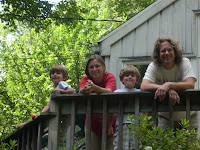A recent MetroPulse article by Alan Sherrod decried the lack or severe dearth, anyway, of classical music performances in the Knoxville area, in fact in the entire state of Tennessee during the summer. I couldn’t agree with him more. Whether due to the stultifying heat, the lack of interest, whatever, outdoor classical music here in the summer is sadly limited to one giant blowout here on the 4th, and the occasional church performance. Fans of Americana, blues, rock, bluegrass and similar genres have a gaggle of opportunities to get their groove on in the area, but classical seems to get short shrift. The Sewanee Summer Music Festival is a prestigious organization that many KSO players’ students attend (violist Hillary Herndon is a faculty member), offering a mix of advanced student and faculty performances, but it is a 2 ½ hour-plus drive from here.
This summer other KSO members have traveled to California, Colorado, New York, Iowa, Massachusetts and Oregon to participate in established summer festivals. The cooler climate of these locales makes outdoor concerts an attractive entertainment option, instead of a sweaty slog.
Given the need for a cooler environment, few East Tennessee towns are qualified candidates for an appealing and profitable summer festival such as Tanglewood, Chatauqua, Crested Butte and Bear Valley. Other drawing cards include a picturesque natural setting, hopefully at a high altitude, plenty of restaurants and better-than-average lodging, easy access from Knoxville via interstates or major highways, historic interest, and plenty of parking. The presence of a college campus, with its lovely air conditioning and ready-made housing and other facilities for participants, is a plus.
I dream of a musical summer in East Tennessee. Gatlinburg, Pigeon Forge, and the like are out of contention in my eyes, at least, due to the sheer volume of traffic and the unlikelihood of a classical festival being a “big fish” in that town’s small pond. I nominate the following towns for consideration for chamber or small symphonic festivals.
Townsend:
The KSO has played at the Great Smoky Mountain Heritage Center for a couple years now. There are scads of lodging and dining choices, and the audience demographic would be quite varied.
Jonesborough:
The oldest town in Tennessee has much to offer. Jonesborough is used to hosting high-quality events that draw a national audience, such as the National Storytelling Festival in October. About a dozen bed and breakfasts and plentiful motels are nearby, with a good variety of restaurants. The altitude is the highest of my choices, making for cool outdoor concert conditions.
Dandridge:
Tennessee’s second oldest town is also quaint and fairly well-endowed with restaurants and accommodations. It is just off the interstate, and the presence of Douglas Lake provides marine access.
Cumberland Gap:
Another quaint old town, it’s at virtually the same elevation as Knoxville despite being in the mountains. There are a few restaurants in the area, but not much within walking distance. Nearby Lincoln Memorial University would be a dandy place for indoor concerts.
Tellico Plains:
Not to be confused with Tellico Village, which is a few miles downstream, Tellico Plains is a well-kept secret that charms the pants of off me whenever I go hiking and camping in the nearby Cherokee National Forest/Indian Boundary Lake area. How this funky little hamlet has escaped development is beyond me. Like Cumberland Gap however, it is remote (about an hour from the nearest interstate), and despite its charm, basic needs for a festival are lacking, like a performance venue and upscale lodging and restaurants. A classical festival would put this town on the map for sure.
Greeneville:
A small city, but not too small, Greeneville would be a good place for a summer concert series. The General Morgan Inn is an elegant old-school hotel that serves as a hangout for KSO musicians when we play concerts at the Niswonger Performing Arts Center. (NPAC seats about 1200). Just a couple doors down is the Capitol Theatre, where we performed before the Niswonger was completed a few years ago. Nearby Tusculum College has yet another performing venue that the KSO has used.
It’s just a dream. But dreams can come true. Don’t wake me up just yet.






